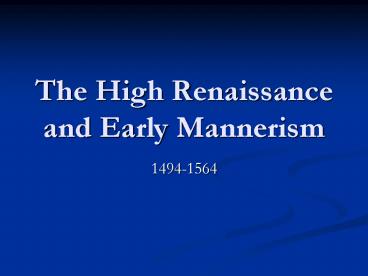The High Renaissance and Early Mannerism - PowerPoint PPT Presentation
1 / 34
Title: The High Renaissance and Early Mannerism
1
The High Renaissance and Early Mannerism
- 1494-1564
2
The High Renaissance
- Center of culture shifted from Florence to Rome
- Popes were leading patrons
- Classical principles of beauty, balance, order,
serenity, harmony and rational design were
perfected
3
The Rise of the Modern Sovereign State
- From 1494-1569, Europes international political
life was controlled by France and Spain. - The new states were strong because they were
united around powerful rulers
4
The Struggle for Italy 1494-1529
- France invaded Italy in 1494
- For 35 years, Italy was a battleground where
France, Spain and the Holy Roman Empire fought
among themselves and the Italian states - In 1527, sack of Rome by Charles V and his troops
5
Charles V and the Hapsburg Empire
- Charles V also known as Charles I of Spain
- Ruled the largest empire the world has ever known
6
Holy Roman Empire
7
Economic Expansion and Social Developments
- A time of growing population and increasing
prosperity Center of commerce shifted from
Mediterranean to the Atlantic coast - London financial center
- Major population shift from rural to urban areas
- Travels to the New World
- Beginnings of slave trade
8
The High Renaissance
- What distinguished High Renaissance from Early
Renaissance? - The artists of the High Renaissance took the
ideas of the Early Renaissance and perfected them - The High Renaissance existed for only a brief
time 1494-1520
9
Mannerism
- Mannerist painters chose odd perspectives
- Rejected idealism
- Turned and twisted the human body into unusual
poses - A denial of the value of human beings and a
negative view of human nature
10
Renaissance Literature
- Writers drew their themes and values from
Greco-Roman classic - Castiglione The Book of the Courtier was one of
the most influential books of the period - Machiavelli The Prince negative view of human
nature Mannerist
11
Painting
- An age of painting
- Classical values of idealism, balance and
restraint - After 1520,, Mannerist tendencies became
prominent - Three major painters of the Renaissance
Leonardo da Vinci, Michelangelo, and Raphael
12
Leonardo da Vinci
- The Last Supper inaugurated High Renaissance
- Mathematical precision, idealism, and
psychological truth
13
Leonardo da Vinci
14
Leonardo da Vinci
15
Leonardo da Vinci
16
Michelangelo
- A painter, sculptor, and architect
- Remained a sculptor at heart
17
Sistine Chapel ceiling
- Combines biblical narrative, theology,
Neo-Platonist philosophy, and Classical allusions
18
Sistine Chapel
19
Sistine Chapel
20
Sistine Chapel
21
Raphael
- Blends sacred and secular
- Expresses the ideals of High Renaissance better
than any other painter
22
Raphael
23
Raphael
24
Venetian PaintersGeorgione
25
Titian
26
ParmigianinoMannerism
27
Sculpture
- Michelangelo- the premier Renaissance sculptor
28
Pieta
29
David
30
Architecture
- Bramante was commissioned to rebuild St. Peters
Basilica - He died before his plans could be carried out
- At the age of 71, Michelangelo was given this
task - In architecture, Michelangelo stayed true to
Renaissance ideals
31
St. Peters Basilica
32
St.. Peters Basilica
33
(No Transcript)
34
(No Transcript)

